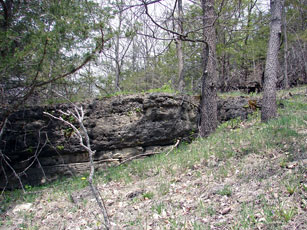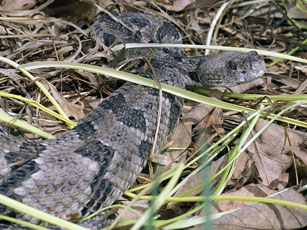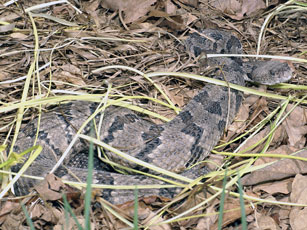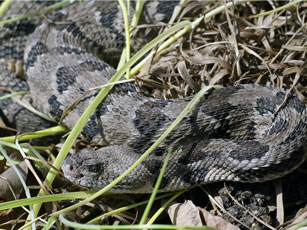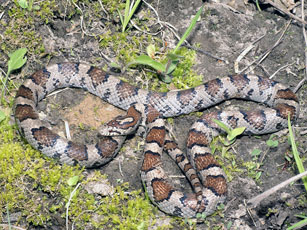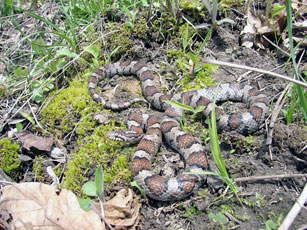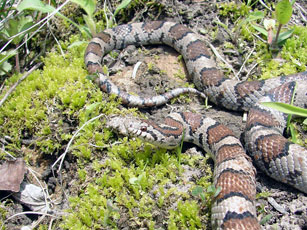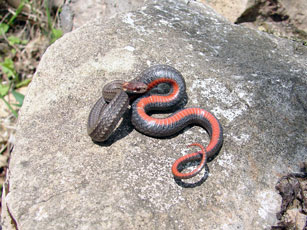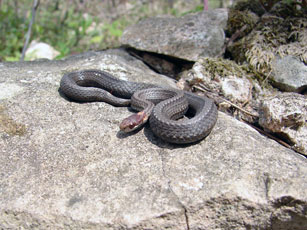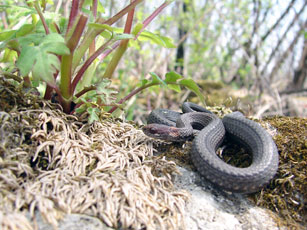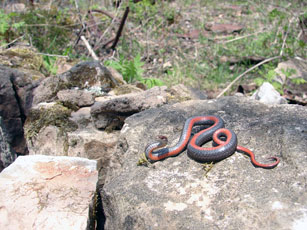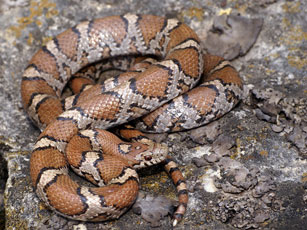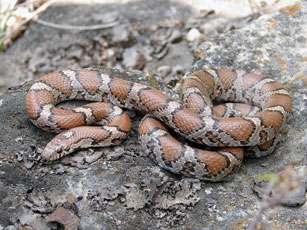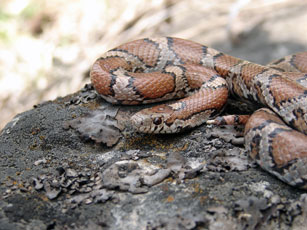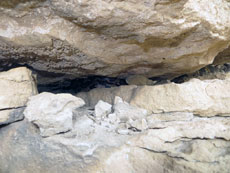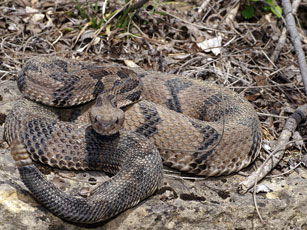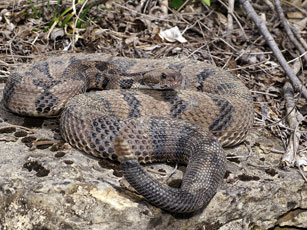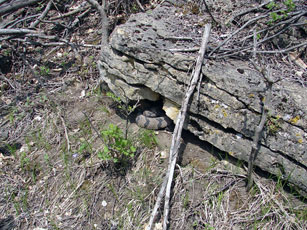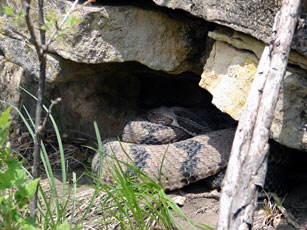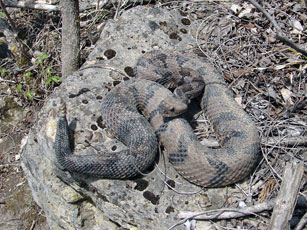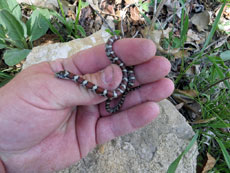
5-2-15
Trip Details
Location: Jackson County, Iowa
eather: 74 degrees. Sunny to partly cloudy. Low wind.
Time: 11:00 a.m.
Herpers: Don Becker, Jim Scharosch & Matt Ricklefs
Account by: Matt Ricklefs
Photos by: Don Becker, Jim Scharosch & Matt Ricklefs
Thought of the Day: One shade of grey is good enough!
Photo by Matt Ricklefs
It was scheduled to be a very nice day and we had a very specific plan in mind. Over the years one of the spots, in fact our first and longest location, that we have gone to for Timber Rattlesnakes have undergone a gradual decline. Some of this has been from people removing or killing animals and some has been from degradation of the habitat due to cedar trees blocking areas of growth and then causing erosion as the ground cover dies off and open dirt is exposed. The area is also due for a burn, but so many conditions have to be right for this and the DNR has other burning priorities. We have done some maintanence with the approval of the DNR, but so much more is needed.
One problem that we have had is that we came into another location that we have spent a lot of time at. We do find more herps (to be honest), but also we have been learning and studying the layout of the area and how things are there. This lessens the time at the older location so we have seen fewer animals. This second location is also private land that we have a large degree of control over from a herping and management standpoint. So, on this day we made a point to go to the old spot. It was early enough that Timbers would be close to or near the dens and we could get a good picture of the early spring activity with the continuing conditions. We also have plans to try and do some aggressive conservation here and wanted to make a specific mental note of the area for clearing.
On this day we were fortunate enough to have Don with us and he had not been to this location so we were glad to have him see this area. We can drive pretty much all the way to our spot so it's a short walk. We had been talking about the habitat and the smaller chance of seeing Timbers, but we were hopeful.
In one spot there is an old sign that was down. It had taken a bit to settle in, but we would occasionally find Milk Snake here. It's a bit of a walk from this to some of the "good" timber locations and it was early so we didn't expect much. We gathered around and lifted to the great surprise of Jim and I we had a Timber Rattlesnake (Crotalus horridus) about 28 inches long and in good condition.
Photos by Jim Scharosch
BUT the truly magical thing about this one is that it was a grey!! This is a location that is fairly unique in that over the years we have found a few grey Timber Rattlesnakes. This is seemingly (since we have no genetic evidence) a recessive genetic trait called anerythrisim, with a complete absence of any yellow/brown color. All the colors are shades of grey with black and white in the normal areas they would occur. Even the eye is a beautiful steely bluish-grey. This was the best find of the last few years. Not only did this area produce a Timber, but also still had this grey anomaly. We had not seen a Timber for a few years and had not seen a grey for even longer. We would never give up on this area, and as sad as it had been seeing the decline, this gorgeous creature helped renew our faith in the efforts to continue to help. As you can see in the pictures, we left the animal totally in situ and disturbed it as little as possible as it had clearly dispersed a ways already (as far as we know from the limited den location info we have here) which was also surprising. The only other finds on this part of the site were several Ring-Neck Snakes (we did not get any pics) but this was also significant as in the past we had found fewer of these. So seeing them was a good sign. We also saw (and heard) a number of Five-Lined Skinks which have remained common here.
We decided to walk the whole area since Don had not been here and we took the long way down really looking around. We came to a few old pieces of tin and were very happy to find a Milk Snake (Lampropeltis triangulum) about 21 inches long.
Photo by Jim Scharosch
Photos by Matt Ricklefs
We had found Red-Bellied Snakes, Brown Snakes, Ring-Necks and garters here but it was just the Milk home today. A little further down, close to an old foundation we did manage to find another welcome find we had not seen for a while, it was a Red-Bellied Snake (Storeria occipitomaculata) about 6 inches long. I took a bit of time and got a few nice shots of this one.
Photos by Matt Ricklefs
That was all for this spot. Since we had time and had done our due diligence here, we decided to go to our other location as well. It was a short drive away and the day was still pretty nice.
It was pretty dry overall, but Jim did round up a very nice Milk Snake about 16 inches long.
Photo by Jim Scharosch
Photos by Matt Ricklefs
We walked to another area here that in the previous fall had uncovered some secrets about. There is an intermediary area between two spots we had seen Timbers regularly. The spot looks picture perfect but we not seen anything here until last fall when we encountered a number of Timbers late in the season staging to over winter at the normal den site. On this day we did not find any Timbers here, but Don was able to snap a nice pic of a Milk tucked comfortably away in a crevice.
Photo by Don Becker
We walked on and as Jim and I were looking up the hill Don was a little further down. About this time Jim mentioned to Don to keep an eye out as the rock outcrop he was coming to often did have Timbers to which Don replied that he found a biggie!
Photos by Jim Scharosch
Photos by Matt Ricklefs
It was a good sized Timber and of all odd coincidences it almost appeared to be a grey! This was a big one at a good 36 inches. We got some in situ shots, but needing to look more closely at the coloration we did take this one out for further verification. It clearly had the dust cover common from emergence so the browns where dulled. We did not have any water with which to rinse it off, but after further examination (though I was pretty hopeful at the time it was a grey here) it was a "normal". One of our friends, Jeff LeClere, did get a glimpse of a Timber with a high amount of black on and around the head. This one did appear a bit lighter, even with the dusting and did have grey eyes. The majority of the Timbers we see here are more golden yellow to brownish. We'll see what pops up in the future. At this point the population seems quite healthy as we regularly find all sizes including juveniles.
We did walk to an area that we find Milks regularly and did just find one juvenile Milk we got a quick picture of. Needles to say it was a very good and interesting day!
Photo by Don Becker
Happy Herpin' Everyone!
Observe and Preserve

